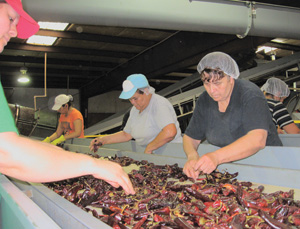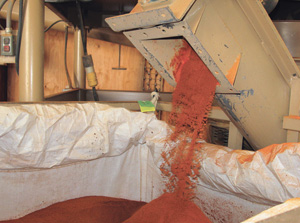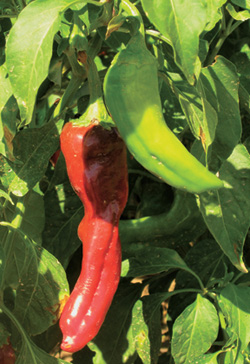The warm, inviting aroma hits your nose immediately upon entering the M.A. and Sons red chile processing plant, and your mouth quickly begins to water. However, throat scratches and nose tickles soon take hold, followed by a single sneeze, which yields a hearty laugh from Randy Garay, whose family operates the facility near Arrey, N.M.

Randy and his son, Darren Garay
Photo courtesy of StollerUSA; Photo by Wylie Maercklein
“You get used to it; you have to,” says Randy. “We’re just processing mild ones today, so one sneeze is nothing. The smell is really strong when we process the extra-hot chile.”
As one of the largest processors in New Mexico’s Hatch Valley, known as the “chile capital of the world,” the family business is no laughing matter. The Garays dehydrate and process 4.4 million pounds of chile annually to make dried chile pods, chile powder, crushed chile and red chile puree.
All in the Family
The company is owned and operated by Mary Alice Garay, an Ag New Mexico, FCS director, and her sons, Frank, Randy and Patrick. Mary Alice’s father owned the processing plant previously. When he wanted to get out of the business in 1989, Mary Alice knew she wanted to follow in his footsteps. She knew that she and her sons had the experience needed for the job — because they grew up in it.

To provide a consistent product, employees at the M.A. and Sons plant inspect dried chile pods for deformities or inconsistencies in color before the pods are packaged or processed into crushed chile, chile puree or chile powder (shown below).
Photo by Sarah Harris
“We were here all the time,” recalls Mary Alice, the executive director of a network of rural health clinics. “I helped my dad a lot when the boys were young. I set up a crib in the ladies’ bathroom and would check on them in between loading the dehydrating tunnels with chile.”
Since then, the now-grown sons, who each have a background in engineering, have been hands-on in the business.
“There’s not a job in here we haven’t done,” Randy says.

Sarah Harris
Growing a Business in a Declining Industry
Despite a continuous decline in the state’s red chile industry, the Garays’ business has done nothing but grow. Mary Alice’s father operated the facility with just three drying tunnels, and over the years, she and her sons have added more drying capacity to reach the 16 tunnels they operate today.
When the brothers felt that the machinery available in the marketplace didn’t fit their operation’s needs, they relied on their own engineering expertise to redesign the equipment. “We built or modified every piece in the plant,” Randy says of the equipment, including a transit track that allows pallets of chile to be easily moved through the facility via a rail system.
In addition to processing, each son also farms red chile. Planted in early to mid-March, the crops take 28 days to germinate and are harvested in October. Randy is quick to acknowledge that red chile is a temperamental and difficult crop to grow.
Complexities of Chile Crops
To prevent disease and increase crop yields, chile cannot be planted in the same field more than once every three to four years, and must be rotated with wheat, barley, oats, corn, alfalfa, sudan grass or cotton. The Garays also farm corn, alfalfa, oats and pecans.
Furthermore, due to the threat of the season’s first freeze, there is only a small window of time to mechanically harvest the crop. Instead, many producers, including the Garays, choose to harvest their chile by hand. Despite their traditional harvesting methods, the Garays do employ more contemporary farming practices. “We use a drip irrigation system, which has really helped us to be more productive,” Randy says. “The plants get exactly as much water as they need, you don’t have to water the furrows, and fertilizers and insecticides can go right into the system.”
A Spicy New Idea
The Garays’ own chile comprises 15 percent of the crop that the plant processes. The rest comes from 14 contract growers in the Hatch Valley and as far away as Mexico and Arizona. During the harvest season, the plant operates 24 hours a day, seven days a week and employs approximately 70 people.
The family didn’t stop there, though. Recognizing the need to diversify their business even further by adding a value-added product to their line, the Garays began producing a red chile puree several years ago. A majority of the whole chile pods are shipped to California and the crushed chile is sent to spice companies across the country, but the puree is only available in grocery stores and in schools in New Mexico and El Paso, Texas. Made for use as a sauce, side dish or soup base, the puree is marketed “sin pellejo,” meaning that all of the stems, seeds and skins have been removed prior to processing.
“We’re basically taking the chile and doing all of the hard work that a home cook is normally doing,” Randy says. “All they have to do is thaw it, boil it, season it, and it’s ready to go.”
Staying a Step Ahead
Mary Alice believes that it’s this extra step and attention to quality that sets their business apart from the competition. “We start off with quality chile, and, through this process, end up with a very high-quality product,” she notes. Randy, on the other hand, says that it’s their role as both farmer and processor that makes the difference.
Warren Russell, their New Mexico lender, agrees with both points of view and knows the family has products worth standing behind.
“As a consumer, I know that their products are better than others out there,” he says. “As their loan officer, I know for these reasons that their growth potential is huge.”
– Staff

Powerful & Potent Peppers
Besides just tasting good, New Mexico red chile boasts some very strong nutritional benefits. It is a good source of iron, potassium, dietary fiber, antioxidants, and vitamins A and C.
Capsaicin, the hot element of the peppers, has proved to be a natural anti-inflammatory, blood thinner, cholesterol inhibitor and decongestant. Studies have also shown that it increases metabolism, is effective in treating migraine, muscle and arthritis pain, and can inhibit the growth of prostate cancer cells.
Powerful & Potent Peppers
Besides just tasting good, New Mexico red chile boasts some very strong nutritional benefits. It is a good source of iron, potassium, dietary fiber, antioxidants, and vitamins A and C.
Capsaicin, the hot element of the peppers, has proved to be a natural anti-inflammatory, blood thinner, cholesterol inhibitor and decongestant. Studies have also shown that it increases metabolism, is effective in treating migraine, muscle and arthritis pain, and can inhibit the growth of prostate cancer cells.